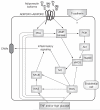Protective vascular and myocardial effects of adiponectin
- PMID: 19029992
- PMCID: PMC2658652
- DOI: 10.1038/ncpcardio1398
Protective vascular and myocardial effects of adiponectin
Abstract
Adiponectin is an abundant plasma protein secreted from adipocytes that elicits protective effects in the vasculature and myocardium. In obesity and insulin-resistant states, adiponectin levels are reduced and loss of its protective effects might contribute to the excess cardiovascular risk observed in these conditions. Adiponectin ameliorates the progression of macrovascular disease in rodent models, consistent with its correlation with improved vascular outcomes in epidemiological studies. The mechanisms of adiponectin signaling are multiple and vary among its cellular sites of action. In endothelial cells, adiponectin enhances production of nitric oxide, suppresses production of reactive oxygen species, and protects cells from inflammation that results from exposure to high glucose levels or tumor necrosis factor, through activation of AMP-activated protein kinase and cyclic AMP-dependent protein kinase (also known as protein kinase A) signaling cascades. In the myocardium, adiponectin-mediated protection from ischemia-reperfusion injury is linked to cyclo-oxygenase-2-mediated suppression of tumor necrosis factor signaling, inhibition of apoptosis by AMP-activated protein kinase, and inhibition of excess peroxynitrite-induced oxidative and nitrative stress. In this Review, we provide an update of studies of the signaling effects of adiponectin in endothelial cells and cardiomyocytes.
Figures



References
-
- Goldstein BJ, Scalia R. Adipokines and vascular disease in diabetes. Curr Diab Rep. 2007;7:25–33. - PubMed
-
- Zhu W, et al. Vascular effects of adiponectin: molecular mechanisms and potential therapeutic intervention. Clin Sci (Lond) 2008;114:361–374. - PubMed
-
- Jay D, et al. Oxidative stress and diabetic cardiovascular complications. Free Radic Biol Med. 2006;40:183–192. - PubMed
-
- Granger DN, et al. Modulation of the inflammatory response in cardiovascular disease. Hypertension. 2004;43:924–931. - PubMed
-
- Ouchi N, et al. Association of hypoadiponectinemia with impaired vasoreactivity. Hypertension. 2003;42:231–234. - PubMed
Publication types
MeSH terms
Substances
Grants and funding
LinkOut - more resources
Full Text Sources
Other Literature Sources
Molecular Biology Databases
